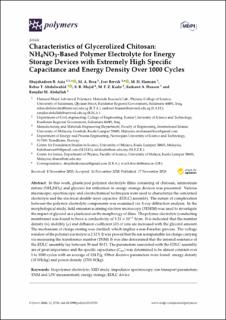| dc.contributor.author | Aziz, S. B. | |
| dc.contributor.author | Brza, M. A. | |
| dc.contributor.author | Brevik, Iver Håkon | |
| dc.contributor.author | Hamsan, M. H. | |
| dc.contributor.author | Abdulwahid, R. T. | |
| dc.contributor.author | Majid, S. R. | |
| dc.contributor.author | Kadir, M. F. Z. | |
| dc.contributor.author | Hussen, S. A. | |
| dc.contributor.author | Abdullah, R. M. | |
| dc.date.accessioned | 2021-01-07T12:30:47Z | |
| dc.date.available | 2021-01-07T12:30:47Z | |
| dc.date.created | 2020-11-18T10:21:32Z | |
| dc.date.issued | 2020 | |
| dc.identifier.citation | Polymers. 2020, 12 (11), . | en_US |
| dc.identifier.issn | 2073-4360 | |
| dc.identifier.uri | https://hdl.handle.net/11250/2722023 | |
| dc.description.abstract | In this work, plasticized polymer electrolyte films consisting of chitosan, ammonium nitrate (NH4NO3) and glycerol for utilization in energy storage devices was presented. Various microscopic, spectroscopic and electrochemical techniques were used to characterize the concerned electrolyte and the electrical double-layer capacitor (EDLC) assembly. The nature of complexation between the polymer electrolyte components was examined via X-ray diffraction analysis. In the morphological study, field emission scanning electron microscopy (FESEM) was used to investigate the impact of glycerol as a plasticizer on the morphology of films. The polymer electrolyte (conducting membrane) was found to have a conductivity of 3.21 × 10−3 S/cm. It is indicated that the number density (n), mobility (μ) and diffusion coefficient (D) of ions are increased with the glycerol amount. The mechanism of charge storing was clarified, which implies a non-Faradaic process. The voltage window of the polymer electrolyte is 2.32 V. It was proved that the ion is responsible for charge-carrying via measuring the transference number (TNM). It was also determined that the internal resistance of the EDLC assembly lay between 39 and 50 Ω. The parameters associated with the EDLC assembly are of great importance and the specific capacitance (Cspe) was determined to be almost constant over 1 to 1000 cycles with an average of 124 F/g. Other decisive parameters were found: energy density (18 Wh/kg) and power density (2700 W/kg) | en_US |
| dc.language.iso | eng | en_US |
| dc.publisher | MDPI | en_US |
| dc.rights | Navngivelse 4.0 Internasjonal | * |
| dc.rights.uri | http://creativecommons.org/licenses/by/4.0/deed.no | * |
| dc.title | Characteristics of glycerolized chitosan:NH4NO3-based polymer electrolyte for energy storage devices with extremely high specific capacitance and energy density over 1000 cycles | en_US |
| dc.type | Peer reviewed | en_US |
| dc.type | Journal article | en_US |
| dc.description.version | publishedVersion | en_US |
| dc.source.pagenumber | 24 | en_US |
| dc.source.volume | 12 | en_US |
| dc.source.journal | Polymers | en_US |
| dc.source.issue | 11 | en_US |
| dc.identifier.doi | 10.3390/polym12112718 | |
| dc.identifier.cristin | 1849110 | |
| dc.description.localcode | © 2020 by the authors. Licensee MDPI, Basel, Switzerland. This article is an open access article distributed under the terms and conditions of the Creative Commons Attribution (CC BY) license (http://creativecommons.org/licenses/by/4.0/) | en_US |
| cristin.ispublished | true | |
| cristin.fulltext | original | |
| cristin.qualitycode | 1 | |

